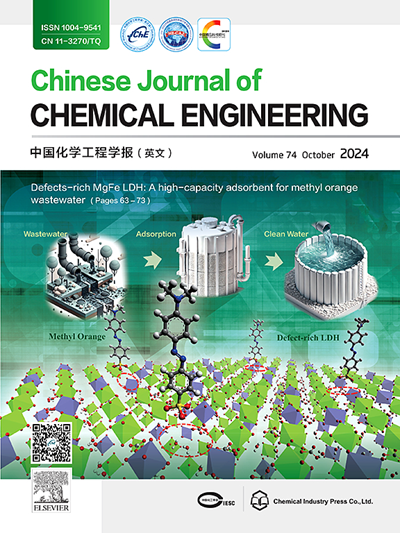Experimental research on enhanced the microfine oil droplets separation using hydrocyclone coupled with fiber coalescence
IF 3.7
3区 工程技术
Q2 ENGINEERING, CHEMICAL
引用次数: 0
Abstract
The limitations of swirl separation in removing microfine oil droplets in water have driven the development of hydrocyclone technology coupled with multiphase or multifield techniques. To enhance microfine oil droplets separation, a novel hydrocyclone separation coupled with fiber coalescence (HCCFC) was designed. The interaction between fiber balls and oil droplets inside the hydrocyclone, including droplet coalescence and breakage, was investigated. The influence of different operating parameters on separation efficiency was discussed. The results showed that fiber balls promoted oil droplet coalescence when the inlet droplet size () was below 22.37 μm but caused droplet breakage above this threshold. The coalescence performance of HCCFC improved with increasing inlet oil content but declined beyond 450 mg·L−1. Separation experiments confirmed that HCCFC outperformed conventional hydrocyclone, with separation efficiency increasing by 2.9% to 20.0%. As the fiber ball content and inlet flow rate increased, the separation efficiency showed a trend of first increasing and then decreasing. Additionally, HCCFC's separation efficiency varied with inlet oil droplet size distribution, showing the most significant enhancement when was 22.37 μm, where separation efficiency increased by 14.4%. These findings offer insights into the development and application of multiphase coupled with hydrocyclone technology.

水力旋流器耦合纤维聚结强化微细油滴分离的实验研究
由于旋流分离技术在去除水中微细油滴方面的局限性,促使了水力旋流器技术与多相或多场技术相结合的发展。为了提高微细油滴的分离效果,设计了一种新型的纤维聚结耦合水力旋流分离器。研究了旋流器内纤维球与油滴的相互作用,包括油滴的聚并和破裂。讨论了不同操作参数对分离效率的影响。结果表明:在进口液滴尺寸(D43)低于22.37 μm时,纤维球对油滴聚结有促进作用,超过该阈值时,则会导致油滴破裂;HCCFC的聚结性能随着进口含油量的增加而提高,但超过450 mg·L−1后,聚结性能下降。分离实验证实,HCCFC比常规水力旋流器分离效率提高2.9% ~ 20.0%。随着纤维球含量和进口流量的增加,分离效率呈现先增加后降低的趋势。HCCFC的分离效率随入口油滴粒径分布的不同而变化,当D43为22.37 μm时,分离效率提高幅度最大,达到14.4%。这些研究结果为多相耦合水力旋流器技术的发展和应用提供了参考。
本文章由计算机程序翻译,如有差异,请以英文原文为准。
求助全文
约1分钟内获得全文
求助全文
来源期刊

Chinese Journal of Chemical Engineering
工程技术-工程:化工
CiteScore
6.60
自引率
5.30%
发文量
4309
审稿时长
31 days
期刊介绍:
The Chinese Journal of Chemical Engineering (Monthly, started in 1982) is the official journal of the Chemical Industry and Engineering Society of China and published by the Chemical Industry Press Co. Ltd. The aim of the journal is to develop the international exchange of scientific and technical information in the field of chemical engineering. It publishes original research papers that cover the major advancements and achievements in chemical engineering in China as well as some articles from overseas contributors.
The topics of journal include chemical engineering, chemical technology, biochemical engineering, energy and environmental engineering and other relevant fields. Papers are published on the basis of their relevance to theoretical research, practical application or potential uses in the industry as Research Papers, Communications, Reviews and Perspectives. Prominent domestic and overseas chemical experts and scholars have been invited to form an International Advisory Board and the Editorial Committee. It enjoys recognition among Chinese academia and industry as a reliable source of information of what is going on in chemical engineering research, both domestic and abroad.
 求助内容:
求助内容: 应助结果提醒方式:
应助结果提醒方式:


